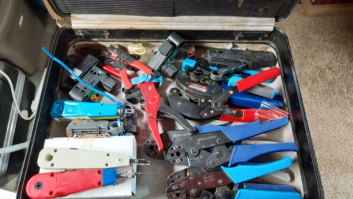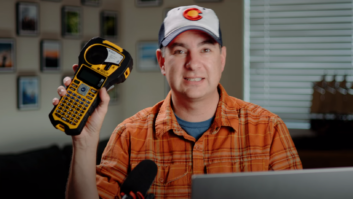(click thumbnail)When the audiocassette was introduced nearly 40 years ago, it created a revolution. The cassette provided an inexpensive, high-quality and convenient recording medium. The masses and professionals readily embraced it.
That was then; this is now. The audio compact disc has eroded the cassette market severely. With blank CDs selling for as low as 20 cents and CD recorders for under $200, the audiocassette is in retreat.
In retreat – yes, but far from dead.
Ubiquitous media
Almost everyone owns several cassette players or recorders, and there are almost as many cassette players in cars as there are cars themselves.
Product CapsuleThumbs Up:
Lightweight
Easy to use
Direct Drive Motors
Quiet operation
Good quality copies
Rugged
Thumbs Down:
U.S. models set to run fast
No user adjustable volume controls
No level indicators to measure output levels
List price starts at $350.
For more information contact Graff Electronic Machines Ltd. in the United Kingdom at +44 (0) 1636-893036, fax +44 (0)1636-893317 or visit the Web site at www.graffelectronics.freeserve.co.uk
Even radio stations and production studios still find plenty of uses for audiocassettes. What better way to make a copy of this morning’s talk show for a listener? How about a quick copy of that new spot for the corner grocery store? And how many news departments still prefer their trusty old cassette recorder?
Additionally, where there are audiocassettes, there is a need to duplicate them. Good cassette duplicators are easy to come by – if money is no object. Most quality, high-speed duplicators run $2,000 or more. That price is a bit stiff if all that is needed is to duplicate a few spots or an occasional program.
But what if you want a low-cost unit? I went looking for a good, affordable, one-to-one duplicator, and was impressed by a unit made by Graph Electronic Machines Ltd. of England. The GEM TurboTrax one-to-one monaural duplicator can be purchased for as little as $350.
Why would a company choose to market a new line of cassette duplicators when the world is marching vigorously toward the digital realm? For an answer, I asked GEM General Manager Alan Leonard.
“Graff Electronic Machines Limited was founded in 1983 by its sister company, Tector Limited, who were manufacturers of visual systems for flight simulators,” said Leonard.
“The purpose (was) to have a product range that would create regular assembly work for a highly skilled production staff who were not always fully occupied on a day-to-day basis due to the lengthy contracts that were involved in flight simulation.”
As to why cassette duplicators in particular, Leonard said, “The reason for choosing duplicators, was to further an engineering concept and our belief that there was a real need in the market for a duplicator that would offer the ease of use and performance that can only be achieved with a true direct drive mechanism.”
Look ma, no belt
The company’s TurboTrax series of duplicators offer some attractive features for a low-cost unit, including a direct-drive system that uses no belts, pulleys or flywheels.
The units feature a microprocessor that controls all functions and even slows the cassettes down prior to stopping in the rewind mode.
The units actually break down into two categories and, from there, into two more subcategories, each with several variations.
One set of duplicators is not expandable. The other can accept slaves to increase the number of cassettes that can be duplicated at one time.
Each of these categories has either a one-to-one or a three-to-one configuration. In addition, the units can be purchased with standard or long-life heads, with or without erase heads. Mono and stereo units are available.
GEM sent me a mono, one-to-one unit with standard heads and an erase head. The unit has a plastic exterior case that is held in place without screws.
After playing with the unit for a few minutes, I finally figured out that the case just snaps in place and I was able to remove the cover to see what makes it tick.
The first thing to catch my eye was the mounting plate. The plate is a rugged, all-steel chassis that should hold up well to any normal abuse.
The second thing to catch my attention was the unit’s simplicity. Three sets of motors exist for each cassette well – two smaller ones for the hubs and one larger one whose shaft serves as the capstan. Missing are the usual flywheels and belts and interconnecting rods.
The motors connect to an electronics board that runs the entire length of the left side of the unit. The board contains the microprocessor as well as the record/play amplifiers and bias electronics for units with erase heads. A hefty power transformer is mounted on the other side of the unit.
All of the heads and idler wheels for both wells are mounted on a common sliding plate. This ensures that the alignment for all wells remains constant.
All in all the TurboTrax is an attractive-looking piece of equipment, but how well does it perform?
The machines are a pleasure to use. I have owned several duplicators, and all of them have been heavy, noisy affairs. At eight pounds the TurboTrax is light in comparison to other units and with direct drive motors, is delightfully quiet.
Operation is simple. Four push buttons control the unit – Rewind, Stop, Copy A and Copy A+B. The unit is so quiet, the user will hardly know it’s running and because of the microprocessor, a user can stop and rewind the cassettes at any time.
The TurboTrax duplicator copies at 16x speed and can rewind a C-60 cassette in approximately 35 seconds. I use C-65 length cassettes and found I could copy a cassette in just over 2 minutes and rewind it in 37 seconds.
New and improved
This was not the first unit I tested. Last year I tested a similar unit and the wow and flutter was unacceptably high. At that time I was told that several design changes were under consideration and I was asked to wait until the changes had been made.
What changes did GEM make in the TurboTrax? Leonard indicated that they had made several changes.
“The overall width of the sliding plate was reduced to give greater rigidity. The method of head mounting was revised to improve alignment between erase and record heads.
“The pinch roller arm was redesigned to give greater rigidity and the pinch roller arm fitted to main chassis instead of the sliding plate to maintain parallel path with capstan shaft. The left hand spool motor (rewind) has improved specifications and all speed control circuitry is now part of main PCB’s to reduce number of interconnections.“
With all of those changes, how would this unit fare? The initial copies I made sounded very good with great levels. I used chrome masters with high-quality, duplicator-grade, regular-bias cassettes for the copies.
Then it was time for serious tests. This time when I ran a frequency run, the tones were steady. The wow and flutter measured out at 0.25-percent – right in the ballpark and quite acceptable for a unit in this price range.
The frequency response was also respectable for a unit in this price range. The response was down -2.5 dB at 50 Hz and -3.0 dB at 5 kHz.
At 6,000 Hz the response was down -7.0 dB, and by 10 kHz it was down -17 dB. When I re-measured the frequency response using cassettes supplied by GEM, the frequency response at 6 kHz improved to -4 dB. While not exactly high fidelity, the frequency response is respectable for a duplicator in this price range.
However, when I checked the timing accuracy, I discovered that the copies were running 1.2 percent faster than the master cassettes. This confirmed what my ears were hearing, i.e.: that the copies sounded a bit higher in pitch.
This result suggested that the copy well was running slower than the master well. When I brought this to the attention of Alan Leonard, he said, “The copy position is factory set to run approximately 1-percent slower than the master position. This was requested by our U.S. dealers from the outset to compensate for variation in tape lengths, and thus ensure the total content of the master is transferred to the copy cassette.”
He said, “The capstan speeds are individually adjustable and can be set to identical frequencies.”
Armed with that information, I recalculated the timing accuracy and it came out to a very respectable 0.2 percent.
All in all, I’m impressed with the Gem TurboTrax cassette duplicator. I have ordered three of the one-to-one units with long life heads from the factory. These will be set with the master and copy wells in sync to ensure proper pitch.
And that would be my caveat: when purchasing a TurboTrax duplicator, specify that the master and copy wells are synchronized.
I did not test a stereo version, so I cannot provide any insight on how well these units might perform. However, I have owned stereo duplicators in this price range manufactured by other duplicator companies, and the results were not good.
It is difficult to maintain sufficient contact between the head and the tape on an inexpensive duplicator. In many cases, the result is unacceptable frequency cancellation when you record a mono tape on a stereo duplicator.
My recommendation is that if you need to duplicate something in stereo, do it on a compact disc. But for inexpensive, monaural duplication, the GEM TurboTrax is a delight to use and provides good quality copies.
If I were making a wish list, I would want level controls and level indicators. But in fairness to GEM, none of the competitors offers these features in a comparably priced unit.
In addition to the TurboTrax series of duplicators, GEM has a line of duplicators, some with Quartz Crystal capstan motors and high-speed digital duplicating from computer to cassette.













